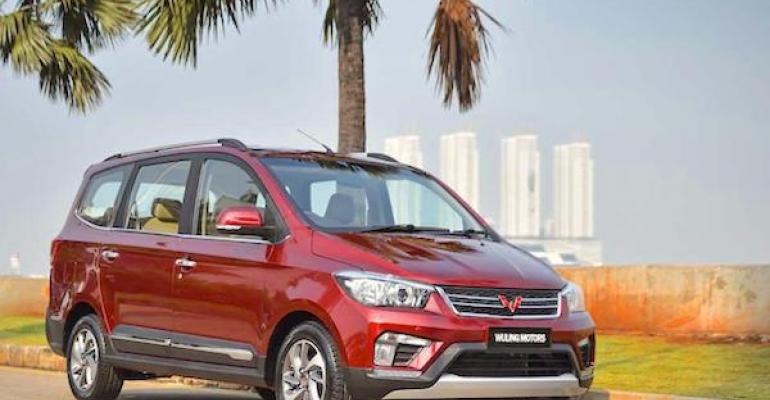SHANGHAI – Chinese customers bought 28 million vehicles in 2016, up 7.3% from 2015, which saw year-on-year growth of 4.7%, according to the China Association of Automobile Manufacturers.
However, such sales largely were stimulated by government tax incentives adopted in 2015 to encourage sales of low-emission cars.
Seeing growth in China’s automotive market slowing down, local automakers, which have amassed significant cash reserves during past periods of surging sales, are keen to expand their global reach.
A recent example of a Chinese automaker looking to grow sales overseas is state-owned SAIC Motor. The Shanghai-based manufacturer is a major local partner of two multinationals, Volkswagen and General Motors, but no longer is it satisfied to be a sidekick.
In July, SAIC-GM and SAIC launched production at SAIC-GM-Wuling, a joint venture in Indonesia to sell two models, the Confero and Confero S, both compact 7-seat multipurpose vehicles. The initiative involved spending $700 million to establish a manufacturing facility in Cikarang – the JV’s first outside China – to compete with Japanese automakers such as Toyota and Honda, which have long dominated the Indonesian market.
According to the JV, the price of its vehicles will be much lower than competing Japanese-branded models. For example, the cost of the lowest-priced Confero will be 130 million Indonesian rupiah ($9,746), about 30% lower than Toyota’s similar Avanza.
SAIC-GM-Wuling plans to sell 40,000 vehicles in 2018 under IR100 million ($7,497) in Indonesia.
Also in July, SAIC bought GM’s factory in Gujarat, India, announcing that the retooled facility in 2019 will launch production of the MG, a brand bought from the defunct U.K. automaker MG Rover Group. According to SAIC, MG models sold in India will include connected cars and alternative-fuel vehicles.
Also, SAIC is building a manufacturing facility in Thailand with its local partner Chia Tai Group to supply the global right-hand-drive market (Thailand, like Japan, drives on the left). SAIC also has established a sales network in 15 countries as well as an R&D center in Silicon Valley, CA.
In a statement, SAIC says it will “build a solid global supply chain and export highly competitive vehicles under China’s ‘One Belt, One Road’ initiative,” which involves government investment in transport links from China to south and southeast Asia, central Asia, Europe and Africa.
Chinese Brands Tough Sell in Mature Markets
However, as with many other Chinese companies across all industries, it will not be easy for a Chinese brand to win overseas customers, especially in mature markets.
“Customers in developed markets are highly brand-conscious. They rarely go for an unfamiliar brand, which, at the current stage, leaves few opportunities for Chinese manufacturers,” says Simon Wang, general manager-automotive China at the German research company GFK.
Yale Zhang, an analyst at Shanghai-based consulting firm AutoForesight agrees, noting local laws and regulations, such as safety and emissions standards, also can curtail sales of Chinese-branded cars. By contrast, overseas sales of Chinese commercial vehicles, which can face fewer regulatory restrictions, have proved easier to secure in developed countries.
“It’s no secret that Chinese-made commercial vehicles are the most cost-efficient, but no Chinese company can claim that it’s a global player until it gets into the passenger sector,” Zhang says.
SAIC declines to comment to WardsAuto on its foreign sales strategy, but according to Chinese business newspaper 21Jingji, SAIC’s major business in developed markets – the European Union, U.K., Australia and New Zealand – is commercial vehicles under the Maxus brand, which was bought from U.K.-based LDV Group in 2009. Citing internal company sources, the newspaper reports SAIC aims to enter the passenger sector in those countries through selling electric vehicles, connected cars and even ride-sharing services.
In short, it will be a very different approach from what SAIC plans for most developing markets, where it aims to sell traditional cars with internal-combustion engines.
GFK’s Wang says such a strategy is well-considered because, while Chinese automakers still may lack the capability to develop highly efficient, powerful engines, they wasted no time developing advanced EVs.
“Multinationals may have a century more experience than China in terms of (combustion-) engine development, but they are on the same page with their Chinese counterparts in terms of EV development,” he says.
Some Chinese companies say they have secured patents for important technologies coveted by multinationals.
One of them is a Hong Kong EV developer Thunder Power, whose CEO Wellen Shen says he turned down an offer from “a top U.S. EV maker” to buy its modular chassis patent.
SAIC plans to focus on solving EVs’ key issue: range. In June, it formed a joint venture with Hong Kong-based Amperex Technology, a major battery supplier to Apple’s smart devices, to develop batteries for SAIC-made EVs. The RMB10 billion ($1.5 billion).
SAIC also plans in 2018 to introduce a new EV model under the Roewe brand that boasts a range exceeding 310 miles (500 km).
“I think the EV segment probably is the only opportunity for Chinese auto manufacturers to sell passenger cars in developed markets, especially now (that) EVs are encouraged by governments everywhere,” GFK’s Wang says.





